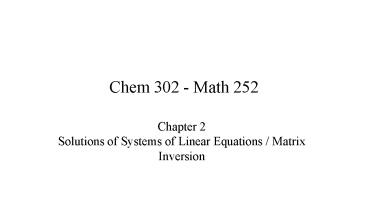Chem 302 Math 252 - PowerPoint PPT Presentation
1 / 26
Title:
Chem 302 Math 252
Description:
Cramer's Rule. Gaussian Elimination. Gauss-Jordan Elimination. Maximum Pivot Strategy ... Cramer's. n. Comparison of Direct Methods. Time required on a 300 ... – PowerPoint PPT presentation
Number of Views:22
Avg rating:3.0/5.0
Title: Chem 302 Math 252
1
Chem 302 - Math 252
- Chapter 2Solutions of Systems of Linear
Equations / Matrix Inversion
2
Solutions of Systems of Linear Equations
- n linear equations, n unknowns
- Three possibilities
- Unique solution
- No solution
- Infinite solutions
- Numerically systems that are almost singular
cause problems - Range of solutions
- Ill-conditioned problem
Singular Systems
3
(No Transcript)
4
(No Transcript)
5
(No Transcript)
6
(No Transcript)
7
Solutions of Systems of Linear Equations
- Direct Methods
- Determine solution in finite number of steps
- Usually preferred
- Round-off error can cause problems
- Indirect Methods
- Use iteration scheme
- Require infinite operations to determine exact
solution - Useful when Direct Methods fail
8
Direct Methods
- Cramers Rule
- Gaussian Elimination
- Gauss-Jordan Elimination
- Maximum Pivot Strategy
9
Cramers Rule
- Write coefficient matrix (A)
- Evaluate A
- If A0 then singular
- Form A1
- Replace column 1 of A with answer column
- Compute x1 A1/A
- Repeat 3 and 4 for other variables
10
Cramers Rule
Not singular System has unique solution
11
Cramers Rule
12
Cramers Rule
- Good for small systems
- Good if only one or two variables are needed
- Very slow and inefficient for large systems
- n order system requires (n1)! (n1)!
Additions - 2nd order 6 , 6
- 10th order 3628800 , 3628800
- 600th order 1.27101408 , 1.27101408
13
Gaussian Elimination
- Form augmented matrix
- Use elementary row operations to transform the
augmented matrix so that the A portion is in
upper triangular form - Switch rows
- Multiply row by constant
- Linear combination of rows
- Use back substitution to find solutions
- Requires ?n3n2- ?n , ?n3½n2- ?n
14
Gaussian Elimination
15
Gauss-Jordan Elimination
- Form augmented matrix
- Normalize 1st row
- Use elementary row operations to transform the
augmented matrix so that the A portion is the
identity matrix - Switch rows
- Multiply row by constant
- Linear combination of rows
- Requires ½n3n2- 2½n2 , ½n3-1½n1
- Can also be used to find matrix inverse
16
Gauss-Jordan Elimination
17
Maximum Pivot Strategy
- Elimination methods can run into difficulties if
one or more of diagonal elements is close to (or
exactly) zero - Normalize row with largest (magnitude) element.
18
Gauss-Jordan Elimination
19
Comparison of Direct Methods
- Small systems (nlt10) not a big deal
- Large systems critical
Number of floating point operations
20
Comparison of Direct Methods
Time required on a 300 MFLOP computer (500 TFLOP)
21
Indirect Methods
- Jacobi Method
- Gauss-Seidel Method
- Use iterations
- Guess solution
- Iterate to self consistent
- Can be combined with Direct Methods
22
Jacobi Method
- Rearrange system of equations to isolate the
diagonal elements - Guess solution
- Iterate until self-consistent
23
Jacobi Method
24
Gauss-Seidel Method
- Same as Jacobi method, but use updated values as
soon as they are calculated.
25
Jacobi Method
Gauss-Seidel Method
26
Indirect Methods
- Sufficient condition
- Diagonally dominant
- Large problems
- Sparse matrix (many zeros)































